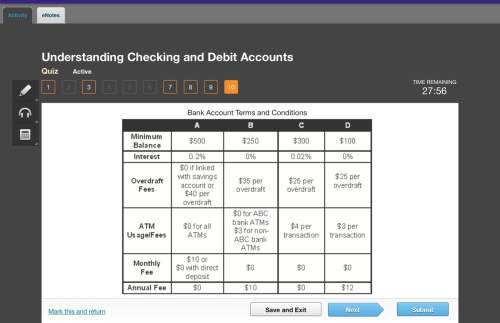
Business, 06.08.2019 23:30 mathman783
If purchasing-power parity between france and the u. s. holds, but then u. s. prices rise, a. the real exchange rate is below its purchasing-power parity value. a decrease in the nominal exchange rate can move it back. b. the real exchange rate is above its purchasing-power parity value. an increase in the nominal exchange rate can move it back. c. the real exchange rate is below its purchasing-power parity value. an increase in the nominal exchange rate can move it back. d. the real exchange rate is above its purchasing-power parity value. a decrease in the nominal exchange rate can move it back.

Answers: 1
Another question on Business

Business, 21.06.2019 18:30
Which stroke of the four-stroke cycle is shown in the above figure? a. power b. compression c. exhaust d. intake
Answers: 2

Business, 22.06.2019 00:30
A) plot the m1 and m2 money stock in the us from 1990-2015. (hint: you may use the data tools provided by fred.) (b) plot the nominal interest rate from 1960 to 2014. (hint: you can either use the daily interest rates for selected u.s. treasury, private money market and capital market instruments from or the effective federal funds rate fromfred.) (c) the consumer price index (cpi) is a measure of the average change over time in the prices paid by urban consumers for a market basket of consumer goods and services. intuitively, the cpi represents the cost of living or the average price level. plot the cpi from 1960 to 2013.(d) the inflation rate is the yearly percentage change in the average price level. in practice, we usually use the percentage change in the cpi to compute the inflation rate. plot the inflation rate from 1960 to 2013.(e) explain the difference between the ex-ante and ex-post real interest rate. use the fisher equation to compute the ex-post real interest rate. plot the nominal interest rate and the ex-post real interest rate from 1960 to 2013 in the same graph.
Answers: 3

Business, 22.06.2019 16:50
Slow ride corp. is evaluating a project with the following cash flows: year cash flow 0 –$12,000 1 5,800 2 6,500 3 6,200 4 5,100 5 –4,300 the company uses a 11 percent discount rate and an 8 percent reinvestment rate on all of its projects. calculate the mirr of the project using all three methods using these interest rates.
Answers: 2

Business, 22.06.2019 19:00
Adrawback of short-term contracting as an alternative to making a component in-house is thata. it is the most-integrated alternative to performing an activity so the principal company has no control over the agent. b. the supplying firm has no incentive to make any transaction-specific investments to increase performance or quality. c. it fails to allow a long planning period that individual market transactions provide. d. the buying firm cannot demand lower prices due to the lack of a competitive bidding process.
Answers: 2
You know the right answer?
If purchasing-power parity between france and the u. s. holds, but then u. s. prices rise, a. the re...
Questions


History, 12.03.2020 17:50









Arts, 12.03.2020 17:51

Mathematics, 12.03.2020 17:51








Social Studies, 12.03.2020 17:52




